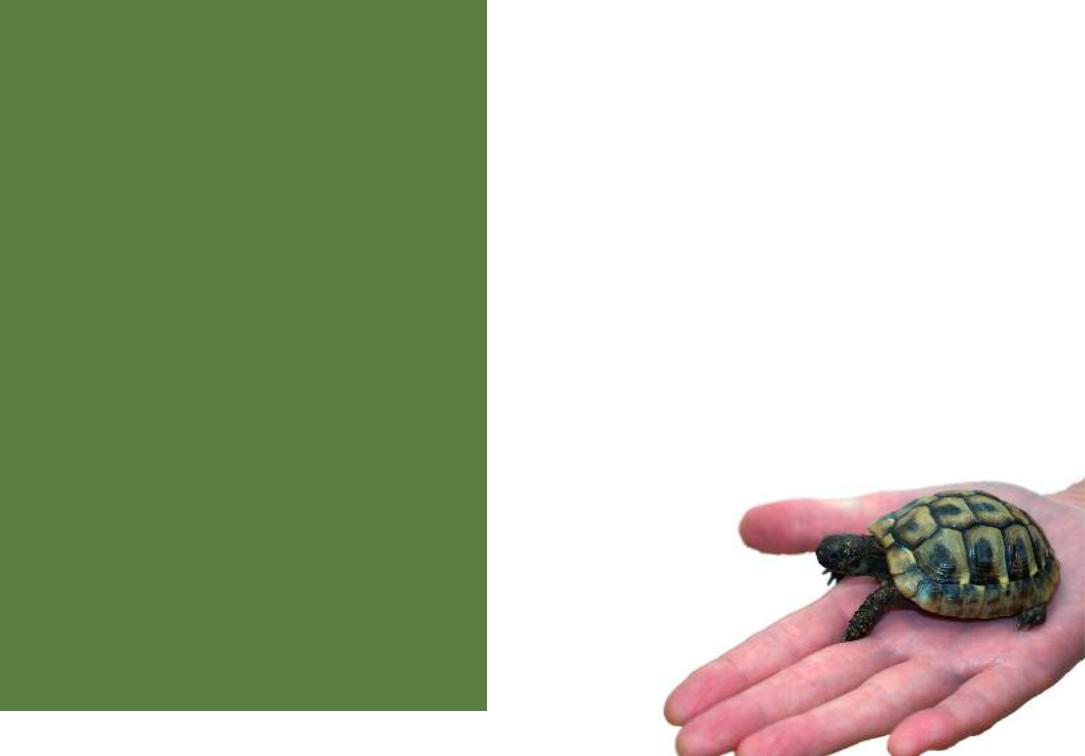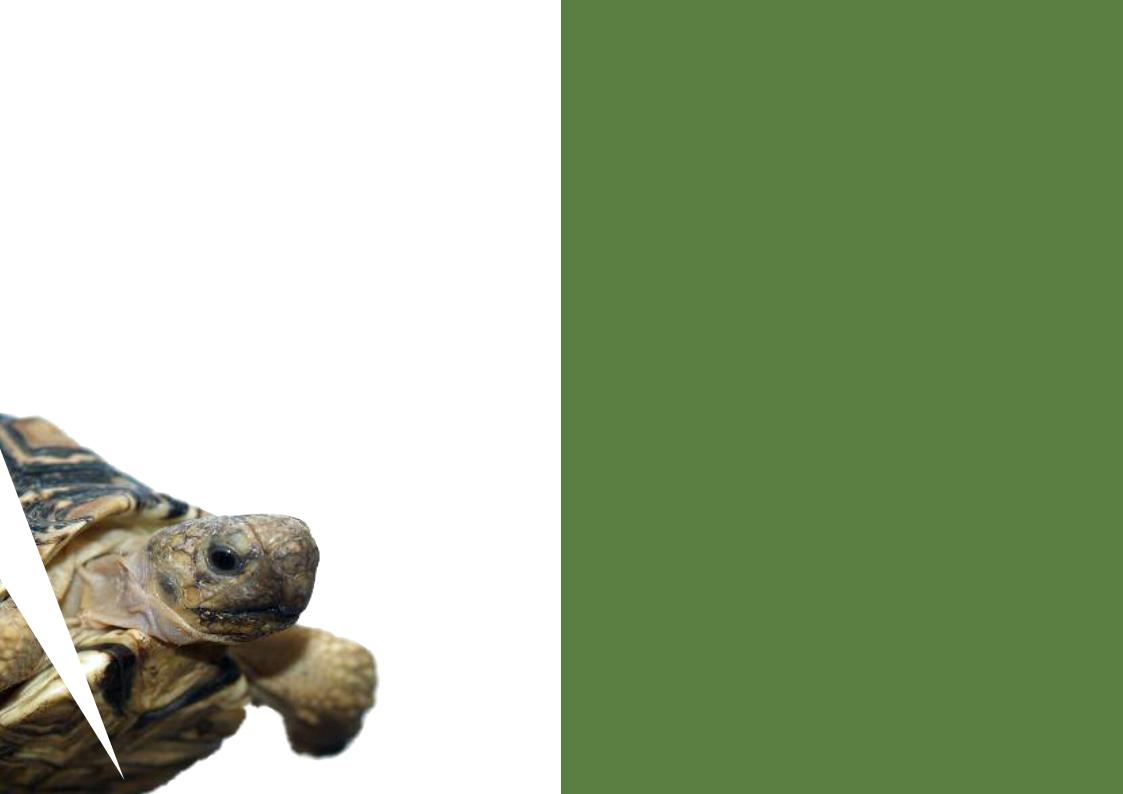
TortoiseTrust__Taking_Care_of_Pet_Tortoises
.pdf
Generalcare
It is critically important to quarantine all new tortoises from existing animals for at least 18 months. New animals may be carrying a wide range of bacterial, parasitic and viral diseases that may not manifest for some considerabletime. It is also very important not to keep different species together in the same habitat. Different species will have different dietary and environmental needs, and may also exhibit mutually antagonistic behaviours. Some species bite and ‘ram’ each other quite violently,for example, while others do not. This will result not only in severe stress but also may cause very serious injuries. Fatalities have also occurred. It is by far the best option to keep different species entirely separately. Two males together may also fight quite violently,and exposing older females to young, aggressive males is also highly inadvisable.
Mediterranean tortoises normally hibernate in the wild. They can do so in captivity (with some exceptions). Examples from certain areas (such as Tunisia and Libya) do not hibernate but instead remain active throughout the winter.These tortoises need to be over-wintered in warm and bright indoor habitats. Hibernation is quite a complex subject in its own right, and the Tortoise Trusthas produced a completely separate free guide on the topic which is available on request. Extensive and up-to-date advice is also freely available on the Tortoise Trustwebsite covering all the different methods of managing hibernation, preparation for hibernation, emergence from hibernation, and the hibernation of juveniles. We advise you to consult these resources for further information as space limitations preclude a sufficiently detailed discussion here.
Even the best kept tortoises may suffer from health problems from time to time, so it is very important that you locate a veterinary surgeon who has a particular interest in, and experience of diagnosing and treating tortoises and turtles. Most tortoise organisationsmaintain
lists of vets recommended by their members. By belonging to a tortoise organisation you will not only remain informed of the latest developments in husbandry,but will also be able to share experiences and advice with fellow enthusiasts.
Frequently Asked
Questions
Is it true that juvenile tortoises have to be kept indoors for the first three to four years as they are too fragile to go outside?
No. Juvenile tortoises, even hatchlings, have exactly the same environmental requirements as adults of their species. Due to their small size, however, they respond more rapidly to temperature changes than large tortoises and they are obviously much more vulnerable to predators. They can go outside in suitable weather, just as adults can, but they need extra measures to be taken for security and protection.
I was looking for a Mediterranean spurthighed tortoise but instead have been offered an African Spurred tortoise. Is there much difference?
Yes. The Mediterranean spur-thighed tortoises are relatively small, up to a maximum of around 30 cm (12”) in length and a
maximum weight of around 6 kg (13 pounds). The African Spurred tortoise (Geochelone sulcata) is one of the largest tortoises in the
world, and can weigh more than 98 kg (216 pounds). Giant tortoises such as these are incredibly demanding and costly to maintain. Please research any species
you are considering carefully in advance. Do not be caught
out by taking on a species you have no realistic hope of caring for properly.
Are there any legal restrictions on keeping and breeding tortoises?
Yes. The law distinguishes between different species, so to answer this fully you need to define the exact species in question. Many ‘common’ tortoises are now covered by C.I.T.E.S (Convention on International Trade in Endangered Species) regulations as well as by individual EU or national laws relating to their sale or possession. Mediterranean tortoises may not be sold or offered for sale unless the seller has a certificate issued by the C.I.T.E.S authorities authorising the sale. Youshould never buy a tortoise unless you are completely satisfied that it is from a legal source. If you breed tortoises yourself, you must hold the relevant certificates before you can sell any offspring.
Juvenile tortoises are more vulnerable to predators
20 |
TortoiseTrustTaking care of pet tortoises |
TortoiseTrust Taking care of pet tortoises |
21 |

I have a female tortoise that has been in the family for many years and I would like to breed with it. Where can I find a male?
You need to be extremely careful when introducing a new tortoise to an existing one. There is not only the danger of disease, but also the possibility of behavioural problems. In addition, you need to be absolutely certain that your female is in good health and is not too old to breed with safely. You should not introduce any other tortoises until you have investigated this thoroughly.
Which species is easiest to keep?
ibera) and the Russian tortoise (Testudo horsfieldii) are among the more straightforward species to keep in captivity. Of the three, the Russian tortoise is more sensitive to damp related problems, but provided the correct accommodation is provided, all three are much less challenging than many other species you may be offered.
Is there any tortoise that I can keep exclusively indoors as I have no access at all to a secure garden?
The Tortoise Trust and the Jill Martin Fund for Tortoise Welfare and Conservation do not feel to keep any tortoise indoors
eed an outdoor area.
in difference between a e and a Mediterranean
ies of tropical tortoises have ironmental and dietary needs nother, so it is not easy to Some of these species (such pard tortoise shown on the
ot |
too |
difficult |
while they |
ll, |
but |
they are |
extremely |
s full grown adults. Think lly and do plenty of research n advance before committing to tortoises like this. The Tortoise Trust has special information available for keepers of tropical tortoises.
Further reading & online resources
Books
The Tortoise Trust Guide to Tortoises and Turtles by A. C. Highfield (Carapace Press)
Keeping a Pet Tortoise by Andy and Nadine Highfield (Interpet Publishing)
The Tortoise and Turtle Feeding Manual
by A. C. Highfield (Carapace Press)
Safer Hibernation & Your Tortoise
(Tortoise Trust, free on request)
Practical Encyclopedia of Keeping and Breeding Tortoises and Freshwater Turtles
by A. C. Highfield (Carapace Press)
Turtles of the World
by Bonin, Devaux and Dupre (A. C. Black Publishers)
Important online resources www.tortoisetrust.org
Official website of the Tortoise Trust. Highly comprehensive reference section of articles on all aspects of tortoise and turtle care, veterinary medicine, field research and conservation. Printed newsletter for members.
www.tlady.clara.net/TortGuide/
Excellent free booklet for downloading on rearing Mediterranean tortoises by Lin King. Includes comprehensive housing, feeding and general husbandry advice.
www.britishcheloniagroup.org.uk
UK based tortoise and turtle society with regular newsletter, meetings and symposia.
www.tortoise.org
The California Turtle and Tortoise Club website. Numerous articles of interest to all keepers.
www.jillmartintortoise.org
Website of the Jill Martin Fund for Tortoise Welfare and Conservation.
www.ttinstitute.co.uk
Runs excellent online educational courses for tortoise keepers.
www.uvguide.co.uk
Outstanding reference site on all aspects of UVB lighting and vitamin D3 synthesis.
www.carapacepress.com
Publishes books and DVDs of interest to tortoise keepers.
Many private keepers maintain their own informative websites. A current list may be viewed at www.tortoisetrust.org/links.html
22 |
TortoiseTrustTaking care of pet tortoises |
TortoiseTrust Taking care of pet tortoises |
23 |
